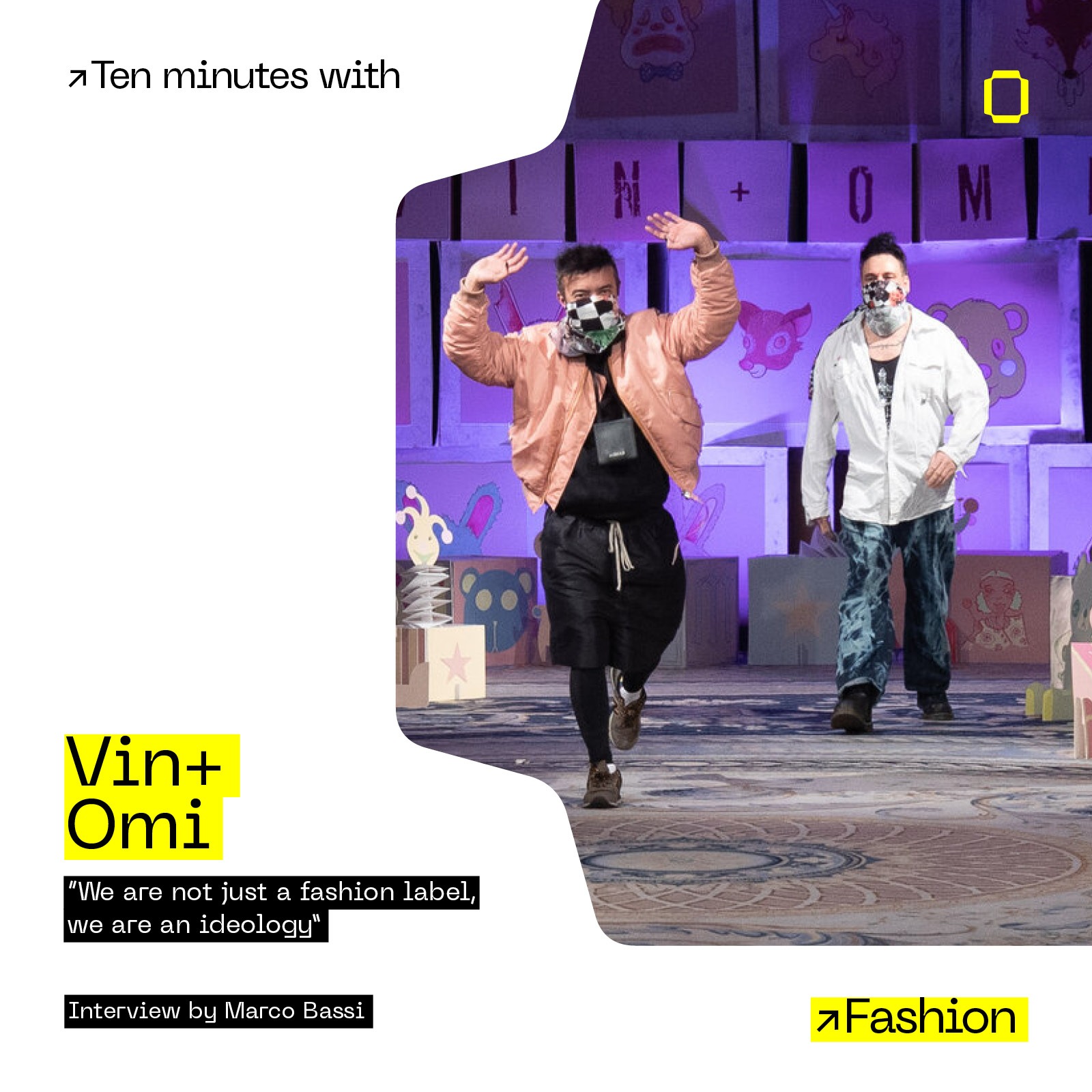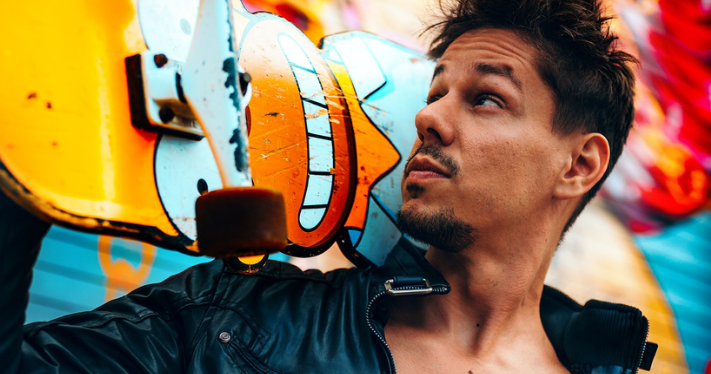VIN + OMI
- May 19, 2023
- 7:48 pm

Introducing VIN + OMI, a dynamic duo of fashion designers who epitomize excellence and
innovation in the modern fashion world. With their exceptional talent and unbridled creativity,
VIN + OMI have quickly gained recognition and admiration within the industry, transforming
runways into captivating works of art. Get ready to be mesmerized by their unique vision and
extraordinary designs.
Introducing VIN + OMI, a dynamic duo of fashion designers who epitomize excellence and innovation in the modern fashion world. With their exceptional talent and unbridled creativity, VIN + OMI have quickly gained recognition and admiration within the industry, transforming runways into captivating works of art. Get ready to be mesmerized by their unique vision and extraordinary designs.
How did you first get interested in sustainability, and how did that lead you to start VIN + OMI?
Vin comes from a background where everything was recycled and waste was minimised from an early age. He also had a sustainable hotel in Ibiza just after leaving university. OMI, through his early work as a fashion photographer, saw the enormous amount of waste produced by the industry and wanted to do something about it. These early experiences filtered into our working practice. From the onset of VIN + OMI we challenged every traditional notion of running a business. One of our early decisions was to challenge the way we used textiles for our projects. We wanted our first fashion collection to be made from latex. We explored the origins of fashion latex and visited the rubber plantations of Malaysia. We realised that the conditions in the planation were not good. The only way to keep our latex supply as eco and sustainable as possible was invest in the plantation and change the way the rubber was produced. We invested in the education programmes for the village, the ecology of the plantation and the sustainability of the rubber production. We have employed this practice of thinking about every aspect of our operations since we first started the brand in 2004.
Your work spans across many genres, including fashion, product and interior design, and consultancy work. How do you incorporate sustainability into each of these areas?
With fashion, product and interior design, for us the provenance of the raw materials matters greatly. They we look at the process to turn those raw materials into something usable, then we look at the carbon footprint and effect of getting those materials to us for use. We then start the designs as the last element of the project. We consult with a large range of companies and industries. We may be commissioned to look at a specific area within the company but we always look at the company holistically. Our consultancy often develops sustainable projects for the client and modifies long time working processes.
Your work often includes social impact projects and campaigns that respond to political and global situations. Can you talk about your creative process and how you use your platform to raise awareness for important issues?
We make sure our studio responds to world events and things we feel passionately about. If we feel strongly about an issue we will creatively incorporate that into our work in a number of ways. For example our Stop Fucking The Planet campaign was initiated by a collaboration with Debbie Harry from Blondie . Our studio came up with the slogan and we produced around 30 garments with the slogan on for her to wear on stage around the world to promote the message. Saving the planet is obviously a theme close to our hearts. During Covid we made a film, via Zoom, called Kepler 62f – this full length feature film featured 80 actors worldwide and examined what would happen to the world in 500 years time when we have to leave the planet as we have ruined this one. During the pandemic we also produced 8,000 masks for our National Health Service immediately until supplies were produced on a regular basis. Our fashion shows are often themed to respond to political or environmental crises and draw attention to that theme.
Your textiles are unique and made via sustainable processes, including ocean and river waste plastic collection schemes and using waste plant sources. Can you talk about your approach to textile development and how you source your materials?
We are constantly evolving and will look at all types of waste that can be utilised for a better purpose. We will work with industry to look at how we can recycle their waste. We can be walking through the countryside and see something, like chestnut casings and then explore how these can be made into a fabric. The origins of all of our textiles are problem solving ones.
VIN + OMI produces the largest fashion shows globally that are focused solely on eco and sustainable processes and textiles. How do you work with host venues to improve their sustainability credentials, and what challenges have you faced in putting on these shows?
It’s quite a large undertaking for a venue to host our shows. We are always full to capacity of whatever space they provide and our backstage team can be upwards of 200 with around 65 models. We can also move into the hotel a month or so prior to the show to prep the collection with our team of assistants. In return for this hosting we develop a range of sustainable projects and strategies with the hotels, these can be community engaging, global or charity focussed. We often revise their waste management systems, or can produce new ways of working with recycled materials; such as revising their staff uniforms or the materials the go into renovations for the hotel . Our shows are run as sustainably as possible with every detail examined to make sure we constantly evolve to think about the impact we are leaving with the shows.
You have a foundation that supports climate and environmental impact projects, as well as research and education programs. Can you talk about some of the projects you’ve supported and how you decide which initiatives to support?
The foundation is currently focusing on clean up schemes worldwide. These schemes are identified via our international team or come in via requests for assistance from our website. We have tended to support waste collection and recycling projects where there is a lapse in government support. This can create a tension with that country as they don’t want to be seen to have a problem. Initially we thought it was a good idea to publicise the problem and draw attention to the issue so we could galvanise more support. In reality this created more tension on often the country would refuse permission for us to help. Now we work more closely with countries and see how our injection of support can leave a legacy and stop the waste or recycling problem occurring again.
What’s next for VIN + OMI, and what are your plans for the future of the brand and your impact on the fashion industry?
Fashion is only a small percentage of our work. We continue to campaign against fast fashion and have taken an active stance agains the British Fashion Council who have been really slow to do anything about the global crisis. We will continue to maintain our position of not selling our clothing ( most of our work goes to museums ) In terms of VIN + OMI’s future progression we have some great projects lined up to focus on spreading a planet saving message. This year we also have 12 new textiles in development and 5 current social impact projects. We are also continuing our work with King Charles. This work started in 2019 and we have collaborated on developing his waste plant materials into new textiles. This has a large educational programme attached. We are currently working with his Sandringham estate to explore how we can best utilise their waste from their vast 20,000 acres.

